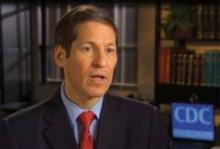The prevalence of infections with the human papillomavirus types included in the quadrivalent HPV vaccine dropped by almost 60% among females aged 14-19 years during the 4-year period after the vaccine became available and was recommended as a routine vaccine in females, according to a Centers for Disease Control and Prevention study.
Considering that only about one-third of younger females have received all three recommended doses of the HPV vaccine, these results are better than expected, according to Dr. Lauri Markowitz, a CDC medical epidemiologist, and her coauthors.
"Our data suggest an early impact of HPV vaccination on vaccine type prevalence among females in the United States, and a high vaccine effectiveness against vaccine type infection," the authors concluded, adding that the decline was "encouraging, given the substantial health and economic burden of HPV-associated disease." The study was published online June 19 in the Journal of Infectious Diseases (doi: 10.1093/infdis/jit192).
"These are striking results, and they should be a wake-up call that we should increase vaccination rates" to protect the next generation of females against cancer caused by HPV infection, CDC Director Dr. Thomas Frieden said during a press briefing held to announce the results of the study. Increasing the vaccination rate to 80% would prevent about 50,000 cases of cervical cancer among girls alive today. "We owe it to the next generation – our sisters, our daughters, our nieces, and to those who are our patients, to protect them against cervical cancer," he added.
A three-dose series of the quadrivalent HPV vaccine (directed against HPV-6, -11, -16, and -18) was recommended by the CDC as a routine vaccine in 2006, for females aged 11-12 years, and for females aged 13-26 years who had not been vaccinated. In 2009, the bivalent HPV vaccine (directed against HPV-16 and -18, the types responsible for about 70% of cervical cancers) was also included in the recommendation. (In 2011, the recommendation for the quadrivalent vaccine was expanded to include boys aged 11 and 12 years, and for unvaccinated males up to age 26 years, but no data are available yet on the proportion of males who have been vaccinated or the impact of vaccination on infection rates.)
The study compared data on the prevalence of HPV infections, based on cervicovaginal samples, from the National Health and Nutrition Examination Survey (NHANES) among females aged 14-59 in two time periods: during 2003-2006, before the vaccine was available, and 2007-2010, after the HPV vaccine became available.
Among females aged 14-19 years, the prevalence of infections with the HPV types in the quadrivalent vaccine dropped from 11.5% during the first period to 5.1% during the second period – a 56% drop. There were no significant differences in infection rates between the two periods for older age groups.
The 56% drop is "greater than expected," considering the vaccine history and estimates of vaccine coverage in national immunization surveys, and could be due to herd immunity from vaccination, effectiveness of fewer than three doses, and/or changes in sexual behavior not measured in the study, Dr. Markowitz and her associates said. Based on NHANES data between 2007 and 2010, only 34% of females aged 14-19 years had received at least one dose of the HPV vaccine. The investigators could not identify any other factors that could explain the reduction in HPV infection, and concluded that the results "suggest an early impact of HPV vaccination."
Among the females aged 14-19 years who were sexually active and were vaccinated, there was an 88% drop in the prevalence of HPV vaccine types between the two time periods, and a 28% drop among those who had not been vaccinated, but the authors could not conclude that herd immunity also contributed to the drop, because of other factors.
There was no change in the rate of sexual activity during the two time periods, Dr. Markowitz, of the Division of STD Prevention in the National Center for HIV/AIDS, Viral Hepatitis, STD, and TB Prevention, said at the briefing. The indication that sexual activity was more common among those who were vaccinated has to be investigated further, she noted. NHANES started collecting data on HPV in males in 2013, and the first data in males will be available in 2015, she said.
HPV is the most common STD in the United States, with about 14 million people becoming infected with HPV every year. About 79 million people who are infected with HPV are in their late teens and early 20s, according to the CDC. About 19,000 cancers in women every year are caused by HPV; most are cervical cancer. About 8,000 cancers caused by HPV occur in men in the United States, with oropharyngeal cancers the most common, according to the CDC.


